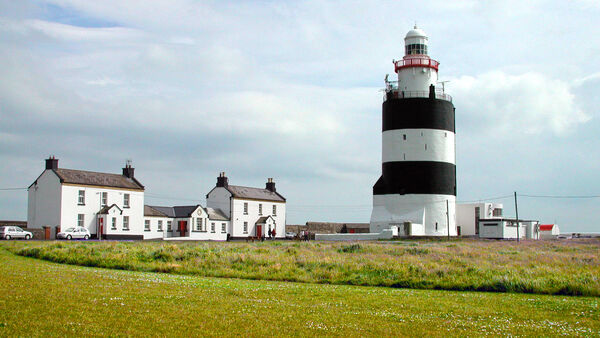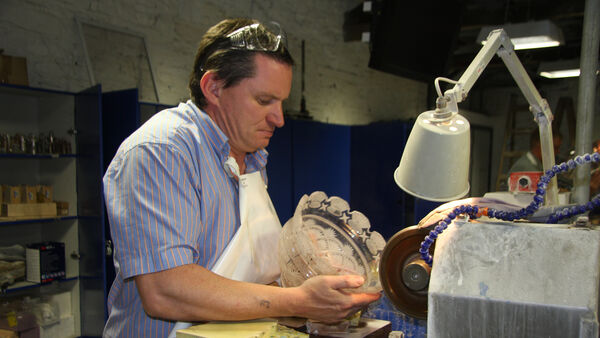Best of South Ireland




By Rick Steves and Pat O'Connor
If you're driving from Dublin to Dingle or the Ring of Kerry with just one overnight, do it in Kilkenny and see Cashel. But if you have a couple of extra days, sleep in Waterford (to see the sights of the southeast) and Kinsale. Here are leprechaun-sized descriptions of the highlights (and one lowlight):
County Wexford
The southeast corner of Ireland, peppered with pretty views and historic sites, is easily accessible to drivers as a day trip from Kilkenny or Waterford. Here are four sights worth considering:
Hook Head Lighthouse claims to be the oldest operating lighthouse in Europe. According to legend, St. Dubhan arrived in the fifth century and discovered the bodies of shipwrecked sailors. Dismayed, he and his followers began tending a fire on the headland to warn future mariners. What you see today is essentially a structure from the 12th century, built by the Normans, who first landed five miles up the east coast. They established Waterford Harbor — a commercial beachhead for the rich Irish countryside they intended to conquer. This beacon assured them safe access.
Since it's a working lighthouse, it can be toured only with a guide. When you're inside — seeing the lighthouse's black-stained, ribbed, vaulted ceilings and stout, 10-foot-thick walls — you can almost feel the presence of the Cistercian monks who tended this coal-burning beacon for the Normans. Climbing 115 steps through four levels rewards you with a breezy, salt-air view from the top.
Patrick Joseph Kennedy, President John F. Kennedy's great-grandfather, left Ireland in 1858. Distant relatives have turned the Kennedy Homestead into a little museum/shrine for Kennedy pilgrims. Physically, it's not much: A barn and a wing of the modern house survive from 1858. JFK and his entourage visited here in June of 1963, a few months before he was assassinated. While it's now just a private home, anyone interested in the Kennedys will find it worth driving the long narrow lane to see.
Permanently moored on a river in the tiny port of New Ross, the Dunbrody Famine Ship was built as a re-creation of similar vessels that sailed to America full of countless hungry Irish emigrants. The Dunbrody is a full-scale reconstruction of a 19th-century three-masted bark built in Quebec in 1845. It's typical of the trading vessels that originally sailed empty to America to pick up goods; during the famine, ship owners found that they could make a little money on the westward voyage. On board, extended families camped out for 50 days on bunk beds no bigger than a king-size mattress. Commonly, boats like this would arrive in America with only 80 percent of their original human cargo (in worst cases, only 50 percent). Those who succumbed to "famine fever" (often typhus or cholera) were dumped overboard, and the ships gained their morbid moniker: "coffin ships."
Visits here include a tour of the ship with an excellent guide, and roots-seekers are welcome to peruse the computerized file of the names of the million immigrants who sailed on these ships from 1846 through 1865.
This 35-acre wooded Irish National Heritage Park features replicas of buildings from each era of Irish history. Since Ireland's countless ancient sights are generally unrecognizable ruins — hard to re-create in your mind — this park is intended to help out. You'll find buildings and settlements illustrating life in Ireland from the Stone Age through the 12th-century Norman Age.
Waterford
The oldest city in Ireland, Waterford was once more important than Dublin. But today, while tourists associate the town's name with its famous crystal, locals are quick to remind you that the crystal is named after the town, not vice versa (come for the crystal, stay for the history). That said, Waterford is a plain, gray, workaday town. Pubs outnumber cafés, and freighters offload cargo at the dock. Wandering the back streets, you'll get a dose of gritty Ireland, with fewer leprechauns per capita than other Irish destinations (though you'll also see some recent sprucing-up efforts as the town tries to shake its mediocre image).
With a tradition dating back to 1783, Waterford was once the largest — and still is the most respected — glassworks in the world. The economic downturn of 2008 shattered the market for luxury items like crystal, forcing the huge Waterford Crystal factory outside town to close. The company was soon after bought by American investors who opened a new, scaled-down factory in the town center (and later sold it to a Finnish company for a handsome profit). While 70 percent of Waterford Crystal is now manufactured by cheaper labor in Poland, Slovenia, and the Czech Republic, the finest glass craftsmen still reside here, where they create "prestige pieces" for special-order customers. The Waterford Crystal Visitor Centre offers a one-hour tour of this hardworking little factory, and it's a joy. It's more intimate than the old, larger factory, and you're encouraged to interact with the craftsmen. Large tour groups descend midday, so try to visit before 10:00 or after 15:30.
Cobh
Cobh sits on a large island in Cork Harbor, connected to the mainland via a short bridge and a drive-on ferry. If your ancestry is Irish, there's a good chance that this was the last Irish soil your ancestors had under their feet. (Cobh was the major port of Irish emigration in the 19th century — of the six million Irish who have emigrated to America, Canada, and Australia since 1815, nearly half left from Cobh.) The town's inviting waterfront is colorful yet salty, with a playful promenade. The butcher's advertisement reads, "Always pleased to meet you and always with meat to please you." Stroll past the shops along the water, and consider taking time for its two main sights.
It's stirring to think that this modest little port town was the Titanic's final anchorage — and the last chance to get off. Occupying the former White Star Line building where the Titanic's final passengers boarded, the compact Titanic Experience museum packs a decent punch as it recounts the story of the ship and its final moments.
Filling a harborside Victorian train station, the Queenstown Story museum is an earnest attempt to make the city's history come to life. The topics — the famine, Irish emigration, Australia-bound prison ships, the sinking of the Lusitania, and the ill-fated voyage of the Titanic — are interesting enough to make it a worthwhile stop.
Kinsale
While Cork is the biggest town in southern Ireland, nearby Kinsale is actually more historic and certainly cuter. Pint-sized and friendly, it's delightful to visit. Thanks to a naturally sheltered bay barbed by a massive 17th-century star fort, you can submerge yourself in maritime history, from the Spanish Armada to the sailor who inspired Defoe's Robinson Crusoe to the Lusitania. Apart from all the history, Kinsale has a laid-back feel with a touch of wine-sipping class.
Between Kinsale and Killarney
The big stop here, at least for the big-bus crowd, is Blarney — an unimportant town with an empty hulk of a castle. It's only famous as the place of tourist pilgrimage, where busloads line up to kiss a stone on its top rampart and get "the gift of gab." The stone's origin is shrouded in myth (perhaps brought back from the Holy Land by crusaders). The best thing about this lame sight is the opportunity to watch a cranky man lower lemming tourists over the edge, belly up and head back, to kiss the stone while an automated camera snaps a photo — which will be available for purchase back by the parking lot. After a day of tour groups mindlessly climbing up here to perform this ritual, the stone can be literally slathered with spit and lipstick.
Near Killarney
Perhaps the best stately Victorian home you'll see in the Republic of Ireland, Muckross House (built in 1843) is magnificently set at the edge of Killarney National Park. It's adjacent to Muckross Farms, a fascinating open-air farm museum that shows rural life in the 1930s. Besides the mansion and farms, this regular stop on the tour-bus circuit also includes a fine garden idyllically set on a lake and an information center for the national park. The poignant juxtaposition of the magnificent mansion and the humble farmhouses illustrates in a thought-provoking way the vast gap that once separated rich and poor in Ireland.
Pat O'Connor is the co-author of the Rick Steves Ireland guidebook.

